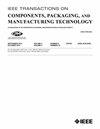An Integrated Multioutput Classification-Based Defect Diagnosis Model for Pick-and-Place Machines
IF 2.3
3区 工程技术
Q2 ENGINEERING, ELECTRICAL & ELECTRONIC
IEEE Transactions on Components, Packaging and Manufacturing Technology
Pub Date : 2025-03-05
DOI:10.1109/TCPMT.2025.3548548
引用次数: 0
Abstract
Surface mount technology (SMT) is a method to mount components directly onto printed circuit boards (PCBs) and is widely used in low-cost and high-density electronic assemblies. Pick-and-place (P&P) is a core procedure for component placing after the solder paste printing (SPP) process in SMT. Generally, the industry uses an automated optical inspection (AOI) machine to detect defects after the components are mounted. However, the AOI machine cannot discern the failures’ root causes and offer reliable P&P machine maintenance references. With the advent of Industry 4.0, machine learning (ML) methods can be applied to improve production line maintenance. Therefore, the traditional check-up process can be changed into a data-driven, predictive, and condition-based maintenance process. Production efficiency can be significantly increased. In this article, a multioutput classification-based defect diagnosis (MCDD) model has been developed to trace the root causes of defects by using the patterns discovered from the experiment data. The experiments with initial machine errors are conducted and investigation information is collected. Compared with the traditional root cause identification model, the developed model is easier to adjust and can achieve an overall classification accuracy of 84.5%. Furthermore, the transfer learning method has been used to apply the trained model for one component to other components and can achieve an accuracy of 81.74%.基于多输出分类的集成拾取机缺陷诊断模型
表面贴装技术(SMT)是一种将元件直接贴装到印刷电路板(pcb)上的方法,广泛应用于低成本和高密度的电子组件中。拣放(P&P)是SMT工艺中焊膏印刷(SPP)后元件放置的核心工序。通常,该行业使用自动光学检测(AOI)机来检测组件安装后的缺陷。然而,AOI机器不能识别故障的根本原因,并提供可靠的P&P机器维修参考。随着工业4.0的到来,机器学习(ML)方法可以应用于改善生产线维护。因此,传统的检查过程可以转变为数据驱动、预测和基于状态的维护过程。可以显著提高生产效率。本文建立了基于多输出分类的缺陷诊断(MCDD)模型,利用从实验数据中发现的模式跟踪缺陷的根本原因。进行了初始机器误差实验,收集了调查资料。与传统的根本原因识别模型相比,所建立的模型更容易调整,总体分类准确率达到84.5%。此外,利用迁移学习方法将训练好的模型从一个组件应用到其他组件,准确率达到81.74%。
本文章由计算机程序翻译,如有差异,请以英文原文为准。
求助全文
约1分钟内获得全文
求助全文
来源期刊

IEEE Transactions on Components, Packaging and Manufacturing Technology
ENGINEERING, MANUFACTURING-ENGINEERING, ELECTRICAL & ELECTRONIC
CiteScore
4.70
自引率
13.60%
发文量
203
审稿时长
3 months
期刊介绍:
IEEE Transactions on Components, Packaging, and Manufacturing Technology publishes research and application articles on modeling, design, building blocks, technical infrastructure, and analysis underpinning electronic, photonic and MEMS packaging, in addition to new developments in passive components, electrical contacts and connectors, thermal management, and device reliability; as well as the manufacture of electronics parts and assemblies, with broad coverage of design, factory modeling, assembly methods, quality, product robustness, and design-for-environment.
 求助内容:
求助内容: 应助结果提醒方式:
应助结果提醒方式:


